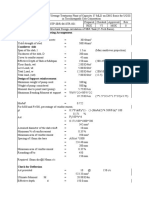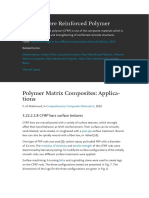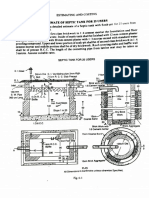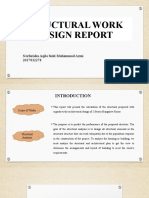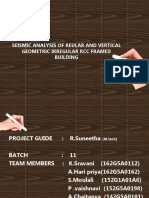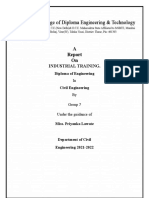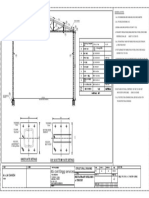Module-4 Pavement Construction: MR - Shankaregowda, Assistant Professor, MIT Mysore 1
Uploaded by
SHRIKANT UGARModule-4 Pavement Construction: MR - Shankaregowda, Assistant Professor, MIT Mysore 1
Uploaded by
SHRIKANT UGARMODULE-4
PAVEMENT CONSTRUCTION
Design of Soil Aggregate Mixes by Rothfutch’s Method
This method is used when a number of materials have to be mixed together for obtaining a
desired or design gradation. The desired gradation may be decided either based on recommended
grain size distribution charts or tables or using the Fuller’s equation.
n
d
P 100
D
Where,
P = Percent finer than diameter‘d’ (mm) in the material
D = Diameter of largest particle, mm
n = Gradation index
On a graph paper, with Y-axis representing percent passing and X-axis representing particle size,
a diagonal line is drawn from point corresponding to 100 percent passing (maximum particle size
of the material) to a point corresponding to zero percent passing (smallest particle size of the
materials). The different particle sizes are marked on X-axis corresponding to the mean values of
percentage finer taken on the Y-axis.
For different materials say A, B and C, sieve analysis has to be done and percentage finer has to
be calculated for each range of particle size for all the materials and grain size distribution curves
of these three materials are plotted and the balancing straight lines of A, B and C are obtained,
allowing only minimum of the areas on either sides of the balancing lines. The opposite ends of
the balancing straight lines of A and B are joined. Similarly the opposite ends of balancing lines
of B and C are joined. The points where these lines meet the desired gradation line represent the
proportion in which the materials A, B and C are to be mixed. These values may be read from
the Y-axis by projecting the points of intersection as shown in Fig 1.
Mr.Shankaregowda, Assistant Professor, MIT Mysore 1
Fig.1: Rothfutch’s Method of Blending Aggregates
Desirable Properties or Requirements of Bituminous Mix for Pavement Construction
Desirable properties of a good bituminous mix are:
1. Stability
2. Durability
3. Flexibility
4. Skid resistance
5. Workability
Stability: Stability is the resistance of the paving mix to deformation under the load. It is the
stress to which specified strain is produced. Depending upon the specification or field condition,
it is influenced by density of the mix or percentage voids in the compacted mix or viscosity of
the bituminous binder.
Durability: It is the resistance of the mix against weathering and abrasive actions. Due to
weathering bituminous mix gets harden which is due to loss of volatiles and oxidation. The
tensile strain is induced due to heavy wheel loads and excessive strain may be developed which
may cause cracks or plastic failure.
Mr.Shankaregowda, Assistant Professor, MIT Mysore 2
Flexibility: It is the property of the mix that measures the level bending strength.
Skid Resistance: It is the resistance of the finished pavement against skidding which depends
upon the surface texture and bitumen content of mix. If the bitumen content is more, the surface
of the pavement is smoothen or slippery. Therefore the bitumen content must be optimum to
have better skid resistance.
Workability: It is the ease with which the mix can be laid and compacted to maximum density.
It is the function of gradation of aggregates, their shape and texture, bitumen content and its type.
Desirable Properties or Requirements of Cement Concrete for Pavement Construction
Properties of Cement Concrete in Plastic State:-
1. Essential Qualities:
• The quality of the hardened concrete is largely dependent on the quality of the plastic
concrete.
• The curing process also contributes to attainment of the specified design criteria.
• Plastic concrete should be workable, free from segregation of the coarse aggregate and of
uniform quality.
2. Workability:
The consistency of the mixture shall be maintained as necessary to obtain the workability
required for the specific conditions and method of placement.
3. No Segregation:
• Plastic concrete should be handled and placed so that it is free from segregation of the
coarse aggregates and completely homogeneous.
• To prevent segregation, the plastic concrete should not be dropped or allowed to fall free
from a distance greater than 3 to 5 feet.
4. Uniformity:
• For uniformity of the mix, every batch should be accurately proportioned in accordance
with design criteria.
• Uniformity increases the economy of the mix and improves the quality of the hardened
concrete.
Mr.Shankaregowda, Assistant Professor, MIT Mysore 3
Properties of Cement Concrete in Hardened State:-
1. Essential Qualities:
• Essential qualities of hardened concrete in pavement are uniform flexural strength and
durability.
2. Strength:
• Concrete pavements must have sufficient flexural strength to carry the required load.
• To attain the desired strength, the most important factor is the ratio of water to cement.
3. Durability:
• Durability of finished concrete is the ability of the artificial stone to resist the effects of
the weather, such as the action of the wind, frost, snow, ice and the combined effects of
wetting-drying and freezing-thawing cycles; the chemical reaction of soils or the effects
of salts; and abrasion.
• Durability is affected by climate, thickness of pavement and exposure.
Earthwork
The subgrade soil is prepared by bringing is to the desired grade and camber and by compacting
adequately. The subgrade may be either in embankment or in cutting, depending on the
topography and finalized vertical alignment of the road to be constructed.
Cutting:
• The cutting is needed in soil, soft rock or even in hard rock, before preparing the
subgrade.
• The selection of excavation equipment and the cost analysis is made based on the
stiffness of the materials to be excavated.
• Earth excavation work may be divided as excavation, grading and compaction.
• The depth of the excavation is decided based on the requirement of the vertical profile of
the road.
• The slope to be provided is governed by the type of soil and the depth of cutting.
The excavation equipments commonly used in highway projects include Bull Dozers,
Scrapers, Power shovels, draglines, Clamshells and Hoes.
Mr.Shankaregowda, Assistant Professor, MIT Mysore 4
Embankment:
• When it is required to raise the grade line of a highway above existing ground level it
becomes necessary to construct embankments.
• The grade line may be raised due to any of the following reasons:
a. To keep the subgrade above the high ground water table.
b. To prevent damage to pavement due to surface water and capillary water.
c. To maintain the design standards of the highway with respect to the Vertical alignment.
The design elements in highway embankment are:
1. Height
2. Fill Material
3. Settlement
4. Stability of Foundation
5. Stability of Slopes
Height: The height of the embankment depends on the desired grade line of the highway and the
soil profile or topography. Also the height of the fill is sometimes governed by stability of
foundation, particularly when the foundation soil is weak.
Fill Material: Granular soil is generally preferred as highway embankment material. Silts and
Clays are considered as less desirable. Organic soils, particularly peat are unsuitable. When the
foundation soil is weak, a light weight fill material like Cinder may be used to reduce the weight.
Settlement: The embankment may be settle after the completion of construction either due to
consolidation and settlement of foundation or due to settlement of the fill or due to both.
Stability of Foundation: It is essential to consider the stability of the foundation against a
failure when the embankment foundation consists of weak soil just beneath or at a certain depth
below in the form of a weak stratum.
Stability of Slopes: The embankment slopes should be stable enough to eliminate the possibility
of a failure under adverse moisture and other conditions. The slope should be designed providing
minimum factor of safety of 1.5. Often much flatter slopes are preferred in highway
embankments due to aesthetic and other reasons.
Mr.Shankaregowda, Assistant Professor, MIT Mysore 5
Construction of Embankment:
The embankment may be constructed either by rolling in relatively thin layers or by
hydraulic fills. The former is called rolled earth method and is preferred in highway
embankments.
• Each layer is compacted by rolling to a satisfactory degree of to a desired density before
the next layer is placed.
• Compaction is carried out at optimum moisture content so as to take advantages of
maximum dry density using a specified compacting effort and equipment.
• The thickness of the layers may vary between 10 to 30cm depending on various factors
such as soil type, equipment, specifications etc.
Preparation of Subgrade
Preparation of Subgrade Includes:
1. Site Clearance
2. Grading (Embankment or Cut Section)
3. Compaction
The subgrade may be situated on embankment or cutting or at the existing ground
surface.
In all the cases, site should be cleared off and the top soil consisting of grass, roots
rubbish and other organic matter are to be removed.
Next, the grading operation is started so as to bring the vertical profile of subgrade to
designed grade and camber.
It is most essential to compact the top of subgrade, up to a depth of about adequately
before placing the pavement layer.
Specification of Materials and Construction Procedure of Granular Sub Base (GSB)
Specifications of Materials:
• The material to be used for the work shall be natural sand, moorum, gravel, crushed
stone, or combination thereof depending upon the grading required.
Mr.Shankaregowda, Assistant Professor, MIT Mysore 6
The material shall be free from organic or other deleterious constituents and conform to
one of the three gradings shown in Table.1.
Table.1: Gradation of Aggregates for Granular Sub Base
IS Sieve Percent by Weight Passing the IS Sieve
Designation Grading-I Grading-II Grading-III
75 mm 100 - -
53 mm 80-100 100 -
26.5 mm 55-90 70-100 100
9.5 mm 35-65 50-80 65-95
4.75 mm 25-55 40-65 50-80
2.36 mm 20-40 30-50 40-65
0.425 mm 10-25 15-25 20-35
0.075 mm 3-10 3-10 3-10
CBR Value, % 30 25 20
(Minimum)
• The material shall have a 10 per cent fines value of 50 kN or more (for sample in soaked
condition) when tested in compliance with BS :812 (Part III) .
• The water absorption value of the coarse aggregate shall be determined as per IS : 2386
(Part 3); if this value is greater than 2 per cent, the soundness test shall be carried out on
the material delivered to site as per IS : 383.
• For Grading II and III materials, the CBR shall be determined at the density and moisture
content likely to be developed in equilibrium conditions which be taken as being the
density relating to a uniform air voids content of 5 percent.
Construction Procedure or Operations:
Preparation of Subgrade:
• Immediately prior to the laying of sub-base, the shall be prepared by removing all
vegetation and other extraneous matter, lightly sprinkled with water if necessary and
rolled with two passes of 80-100 kN smooth wheeled roller.
Spreading and Compacting:
• The sub-base material of grading specified in the contract shall be spread on the prepared
subgrade with the help of a motor grader of adequate capacity.
• Mixing shall be done mechanically by the mix-in-place method.
• The equipment used for mix-in-place construction shall be a rotavator or similar
approved equipment capable of mixing the material to the desired degree.
Mr.Shankaregowda, Assistant Professor, MIT Mysore 7
• Moisture content of the loose material shall be checked in accordance with IS: 2720
(Part-2) and suitably by sprinkling additional water from a truck mounted or trailer
mounted water tank.
• Immediately thereafter, rolling shall start.
• Rolling shall be continued till the density achieved is at least 98 percent of the maximum
dry density for the material determined as per IS: 2720 (Part 8).
Specification of Materials and Construction Procedure of Water Bound Macadam (WBM)
Specifications of Materials:
a) Physical requirements of aggregates – Coarse aggregates shall be crushed stone & it
should conform to the physical requirements said in Table.2.
Table.2: Physical Requirements of Aggregates for WBM
Sl. No. Property Requirements
1 Los Angeles Abrasion Value 50% (Max)
2 Aggregate Impact Value 40% (Max)
3 Flakiness Index 15% (Max)
If the water absorption value of aggregates is greater than 2%, soundness test is carried out.
b) Grading Requirements of Coarse Aggregates: The coarse aggregates for each layer of
construction should be conform to any one of the three gradings shown in Table.3
Table.3: Gradation of Coarse Aggregates for WBM
Grading No. Size Range, mm Sieve Size, mm Percent Passing the
Sieve
100 100
80 65-85
1 90 to 40 63 25-60
40 0-15
20 0-5
80 100
63 90-100
2 63 to 40 50 30-70
40 0-15
20 0-5
63 100
50 95-100
3 50 to 20 40 35-70
20 0-10
10 0-5
Mr.Shankaregowda, Assistant Professor, MIT Mysore 8
c) Grading Requirements of Screenings – The screenings are used to fill up the voids in the
compacted layer of coarse aggregates. The screenings consist of aggregates of smaller
size, generally of the same material as the coarse aggregates. The grading requirements of
screenings for WBM construction are given in Table.4
Table.4: Gradation Requirements of Screenings
Classification of Size f Screenings, Sieve Size, mm Percent Passing the
Grading mm Sieve
12.5 100
10 90-100
A 12.5 4.75 10-30
0.15 0-8
10.0 100
B 10.0 4.75 85-100
0.15 10-30
Construction procedure:
Preparation of Foundation for Receiving the WBM Course:
The foundation for receiving the new layer of WBM may be either the subgrade or
sub-base.
This foundation layer is prepared to the required grade and camber and the dust and loose
materials are cleaned.
Provision of Lateral Confinement:
Lateral confinement is provided before starting WBM construction.
This may be done by constructing the shoulders to advance, to a thickness equal to
that of the compacted WBM layer and by trimming the inner sides vertically.
Spreading of Coarse Aggregates:
The coarse aggregates are spread uniformly to proper profile to even thickness upon
the prepared foundation and checked by templates.
The WBM course is normally constructed to compacted thickness of 7.5 cm.
Rolling:
After spreading the coarse aggregates properly, compaction is done by three wheeled
power roller of capacity 6 to 10 tonnes or alternatively by an equivalent vibratory
roller; the weight of the roller depends on the type of coarse aggregates.
Rolling is started from the edges, the roller being run forward and backward until the
edges are compacted.
Mr.Shankaregowda, Assistant Professor, MIT Mysore 9
The run of the roller is then gradually shifted towards the centre line of the road,
uniformly overlapping each preceding rear wheel track by one half widths. This
process is repeated by rolling form either edge towards the centre line until the
adequate compaction is achieved.
Application of Screenings:
After the coarse aggregates are rolled adequately, the dry screenings are applied
gradually over the surface to fill the interstices in three or more applications.
Dry rolling is continued as the screenings are being spread and brooming carried out.
Sprinkling and Grouting:
After the application of screenings, the surface is sprinkled with water, swept and
rolled.
Wet screenings are swept into the voids using hand brooms.
Additional screenings are applied and rolled till the coarse aggregates are well bonded
and firmly set.
Application of Binding Material:
After application of screening and rolling, binding material is applied at a uniform
and slow rate at two or more successive thin layers.
After the each application of binding material, the surface is sprinkled with water and
wet slurry swept with brooms to fill the voids. This followed by rolling with a 6 to 10
tonnes roller and water is applied to the wheels to wash down the binding materials
that sticks to the roller.
Setting and Drying:
After final compaction, the WBM course is allowed to set over-night.
No traffic is allowed till the WBM layer sets and dries out.
Mr.Shankaregowda, Assistant Professor, MIT Mysore 10
Specification of Materials and Construction Procedure of Wet Mix Macadam (WMM)
Specifications of Materials:
Physical requirements of aggregates – Coarse aggregates shall be crushed stone & it
should conform to the physical requirements Shown in Table.5.
Table.5: Physical Requirements of Aggregates for WMM
Sl. No. Property Requirements
1 Los Angeles Abrasion Value 40% (Max)
2 Aggregate Impact Value 30% (Max)
3 Combined Flakiness and 30% (Max)
Elongation Index
If the water absorption value of aggregates is greater than 2%, soundness test is carried out.
Grading Requirements of Coarse Aggregates: The coarse aggregates for each layer of
construction should be conform to the gradation shown in Table.6.
Table.6: Gradation of Coarse Aggregates for WMM
IS Sieve %Weight by Passing the IS
Designation, mm Sieve
53 100
45 95-100
26.5 -
22.4 60-80
11.2 40-60
4.75 25-40
2.36 15-30
0.6 8-2
0.075 0-8
Construction procedure:
Preparation of Foundation for Receiving the WMM Course:
The foundation for receiving the new layer of WBM may be either the subgrade or
sub-base.
This foundation layer is prepared to the required grade and camber and the dust and loose
materials are cleaned.
Mr.Shankaregowda, Assistant Professor, MIT Mysore 11
Provision of Lateral Confinement of Aggregates:
While constructing WMM, arrangement shall be made for lateral confinement of wet
mix. This shall be done by laying in adjoining shoulders along with WMM.
Preparation of Mix:
WMM is prepared in mixing plant where pug mill or pan type mixer of concrete
batching plant is used.
Optimum moisture for mixing is determined at the time of compaction; water in the
WMM should not vary from optimum value.
The mixed material should be uniformly wet and no segregation is permitted.
Spreading of Mix:
Immediately after mixing it is spread uniformly and evenly on prepared sub-base. In no case
it should be dumped in heaps.
The mix may be spread by paver finisher or motor grader.
The motor grader is cable of spreading the material uniformly so as to achieve the specified
slope & grade.
No segregation of large and fine particles should be allowed.
Compaction:
After the mix has been laid to require thickness, grade and cross fall the same shall be
compacted uniformly to the full depth by roller.
If the thickness is 100 mm single layer, smooth wheel roller is used. For compacted
single layer up to 200 mm vibratory roller is used.
Same kind of rolling as in WBM is done as we discussed before.
Along forms, kerbs, walls or other inaccessible places for rollers, mechanical tampers
or plate compactor is used.
Rolling should not be done when the subgrade in soft.
If irregularities develop during rolling which exceed 12 mm when tested with 3m
straight edge, the surface should be loosened & premixed material added or removed.
Rolling shall be continued till the density achieved is at least 98% of the maximum
dry density for the materials.
After completion, the surface of any finished layer is well closed, free from
movement under compaction equipment or any compaction planes, ridges, cracks and
loose material.
All loose, segregated area shall be made good to the full thickness of layer and
re-compacted.
Mr.Shankaregowda, Assistant Professor, MIT Mysore 12
Setting and Drying:
After final compaction of wet mix macadam course, the road shall be allowed to dry for
24 hours.
Opening to Traffic:
Preferably no vehicular traffic or any kind should be allowed on finished WMM surface
till it has dried & the wearing course is laid.
Specification of Materials and Construction Procedure of Bituminous Macadam (BM)
Specification of Materials:
a) Bitumen : The grades of bitumen used are 30/40, 60/70 and 80/100.
b) Coarse aggregates:
1. Los Angeles Abrasion Value - 50% Max
2. Aggregates Impact Value - 35% Max
3. Flakiness index - 15% Max
4. Stripping at 40°C after 24 hours immersion – 25% Max
5. Loss with Sodium Sulphate - 12% Max
6. Water Absorption - 2% Max
For binder course the specified maximum abrasion and impact values are 40 and 30 percent
respectively.
c) Gradation of Aggregates: The aggregates for each layer of construction should be conform
to any one of the three gradings shown in Table.7
Table.7: Gradation of Aggregates for BM
IS Sieve Base Course Base Course or Binder Course
Designation, mm
Grading 1 Grading 2 Grading 3
63 100 100 -
50 - 90-100 -
40 35-70 35-65 100
25 - 20-40 70-100
20 0-15 - 50-80
12.5 - 5-20 -
10 - - 25-50
4.75 - - 10-30
2.36 0-5 0-5 5-20
0.075 0-3 0-5 0-4
Binder Content, % 3.0-4.5 3.0-4.5 3.0-6.0
Mr.Shankaregowda, Assistant Professor, MIT Mysore 13
Requirements of the Mix:
Marshall stability : 900 kg (minimum)
Marshall flow : 2 – 4 mm
Air voids : 3 – 5%
Voids in the Mineral Aggregate (VMA ): 10 – 12%
Voids Filled with Bitumen (VFB): 65 – 75%
Construction Procedure:
Preparation of Existing Layer:
The existing layer is prepared to proper profile.
Pot holes are patched and irregularities are made even.
The surface is properly cleaned.
Tack Coat or Prime Coat Application:
A tack coat or prime coat is applied of thin layer of bitumen binder n the existing layer
either using sprayer or pouring can.
The quantity of application is 4.0 to 7.5 kg per 10 m2 for black top layer and 7.5 to 10 kg
per 10 m2 for untreated WBM layer.
Premix Preparation:
The bitumen and aggregates as per recommended gradings are separately heated to the specified
temperatures and are then placed in the mixer chosen for the job.
The mixing is done till a homogeneous mixture is obtained. The mixture then carried to the site
for its placement through a transporter or wheel barrow.
Placement:
The bituminous mixture is then immediately placed on the desired location and is spread with
rakes to a predetermined thickness.
The camber profile is checked with a template.
Rolling and Finishing the Paving Mix:
The rolling is done with 8 to 10 tonnes tandem roller.
The rolling is commenced from the edges of the pavement construction towards centre and
uniform overlapping is provided.
The finished surface should not show separate lines of markings due to defective or improper
rolling.
The roller wheels are kept damp, otherwise the paving mix may partly stick to the wheels and
finishing may not be good.
A variation of 6 mm over 3 m length is allowed in the cross profile.
The number of undulations exceeding 10 mm should be less than 30 in 300 m length of
pavement.
Mr.Shankaregowda, Assistant Professor, MIT Mysore 14
Specification of Materials and Construction Procedure of
Dense Bituminous Macadam (DBM)
Specification of Materials:
a) Bitumen – Grade S65 or A65 (60/70 at present VG30), S90 (80/100 at present
VG10) may be used.
b) Coarse aggregates –
1) Los Angeles Abrasion Value - 40% Maximum
2) Aggregates Impact Value - 30% Maximum
3) FI & EI - 30% Maximum
4) Stripping - Minimum retained
5) Loss with Sodium Sulphate - 12% Maximum
6) Water Absorption - 2% Maximum
Fine Aggregates – should be the fraction passing 2.36mm sieve and retained on 0.075mm
sieve.
c) Gradation of Aggregates: The aggregates for each layer of construction should be
conform to gradation shown in Table.8.
Table.8: Gradation of Aggregates for DBM
Sieve Size, % Passing by
mm Weight
37.5 100
26.5 90-100
13.2 56-80
4.75 29-59
2.36 19-45
0.3 5-17
0.075 1-7
d) Filler: The filler for each layer of construction should be conform to gradation shown
in Table.9.
Table.9: Gradation of Filler for DBM
Sieve Size, mm % Passing by
Weight
0.6 100
0.3 95-100
0.075 85-100
Mr.Shankaregowda, Assistant Professor, MIT Mysore 15
e) Requirement of Mix:
e) Marshall stability : 900Kg (minimum)
f) Marshall flow : 2 – 4 mm
g) Air voids : 3 – 5%
h) VMA : 10 – 12%
i) VFB: 65 – 75%
j) Binder Content : Not less than 4%
Construction procedure:
Preparation of Base :
• The surface should be kept clean using mechanical broom and is prepared to uniform
grade.
• Prime coat may be used and tack coat is applied over base.
Premix Preparation:
The bitumen and aggregates as per recommended gradings are separately heated to the
specified temperatures and are then placed in the mixer chosen for the job.
The mixing is done till a homogeneous mixture is obtained. The mixture then carried to
the site for its placement through a transporter or wheel barrow.
Spreading of Mix :
• It is spread by self propelled paver for spreading, tamping & finishing the mix to desired
grade.
• In restricted areas & narrow widths, manual laying of mix or mechanical paver are used.
• Temperature is 120°– 160°C at the time of laying.
Rolling :
• It is compacted initially by smooth wheeled roller, intermediate rolling by vibratory roller
or pneumatic roller & finishing rolling is done by tandem roller.
• The rollers shall not be allowed to stand on pavement which has not been full compacted
and temperature is more than 70°C.
• The wheels of roller shall be kept moist to prevent adhesion.
• Rolling with start from edge to centre line of pavement, both directions. Each pass of
roller shall overlap one by half the width of rear wheel.
Mr.Shankaregowda, Assistant Professor, MIT Mysore 16
• Rolling shall be continued till the density achieved is at least 98%.
• It is completed in all respects before the temperature of mix falls below 100°C.
Opening to Traffic :
• Traffic may be allowed after completion of the final rolling is done.
• DBM is provided with proper wearing course before opening to normal traffic or rain.
Specification of Materials and Construction Procedure of Bituminous Concrete (BC)
Specification of Materials:
a) Bitumen – Grade S65 or A65 (60/70 at present VG30), S90 (80/100 at present
VG10) may be used.
b) Coarse aggregates –
1) Los Angeles Abrasion Value - 40% Maximum
2) Aggregates Impact Value - 30% Maximum
3) FI & EI - 30% Maximum
4) Stripping - Minimum retained
5) Loss with Sodium Sulphate - 12% Maximum
6) Water Absorption - 2% Maximum
Fine Aggregates – should be the fraction passing 2.36mm sieve and retained on 0.075mm
sieve.
c) Gradation of Aggregates: The aggregates for each layer of construction should be
conform to gradation shown in Table.10.
Table.10: Gradation of Aggregates for BC
Sieve Size, % Passing by
mm Weight
26.5 100
19 90-100
9.5 56-80
4.75 35-65
2.36 23-49
0.3 5-19
0.075 2-8
Mr.Shankaregowda, Assistant Professor, MIT Mysore 17
d) Filler: The filler for each layer of construction should be conform to gradation shown
in Table.11.
Table.11: Gradation of Filler for BC
Sieve Size, mm % Passing by
Weight
0.6 100
0.3 95-100
0.075 85-100
e) Requirements of Mix:
• Marshall Stability : 900Kg (Minimum)
• Marshall Flow: 2 – 4 mm
• Air Voids : 3 – 5%
• VMA : 11 – 13%
• VFB : 65 – 75 %
• Binder Content: Not less than 4.5%
• Water Sensitivity : Minimum 75%
• Swell Test :1.5% Maximum
Construction Procedure:
Preparation of Base :
• The base on which bituminous concrete is to be laid shall be prepared, shaped and
conditioned to the specified levels of grade and Camber.
• The surface shall be thoroughly kept clean free from dust and other matter using
mechanical broom and dust removed by mechanical means or blown off by compressed
air. In portions where mechanical means cannot reach, other approved method is used.
Premix Preparation:
The bitumen and aggregates as per recommended gradings are separately heated to the
specified temperatures and are then placed in the mixer chosen for the job.
The mixing is done till a homogeneous mixture is obtained. The mixture then carried to
the site for its placement through a transporter or wheel barrow.
Spreading of Mix :
• It is spread by self propelled paver for spreading, tamping & finishing the mix to desired
grade.
Mr.Shankaregowda, Assistant Professor, MIT Mysore 18
• In restricted areas and narrow widths, manual laying of mix or mechanical paver are
used.
• Temperature is 120°– 160°C at the time of laying.
Rolling:
• It is compacted initially by smooth wheeled roller, intermediate rolling by vibratory roller
or pneumatic roller & finishing rolling is done by tandem roller.
• The rollers shall not be allowed to stand on pavement which has not been full compacted
and temperature is more than 70°C.
• The wheels of roller shall be kept moist to prevent adhesion.
• Rolling with start from edge to centre line of pavement, both directions. Each pass of
roller shall overlap one by half the width of rear wheel.
• Rolling shall be continued till the density achieved is at least 98%.
• It is completed in all respects before the temperature of mix falls below 100°C.
Opening to Traffic :
• Traffic may be allowed immediately after completion of final rolling when the mix has
cooled down to surrounding temperature.
Dry Lean Concrete (DLC)
Dry Lean Concrete (DLC) is an important part of modern rigid pavement.
• It is a plain concrete with a large ratio of aggregate to cement than conventional concrete
and generally used as a base/sub base of rigid pavement.
• It is generally manufactured with ordinary Portland cement (OPC).
Pavement Quality Concrete (PQC)
• Pavement quality concrete is that concrete which is used mostly for highway construction
and it differs from normal conventional concrete by using 32 mm size aggregate.
• This type of concrete requires little more cement content as compared to that of normal
concrete and is mostly designed for M45 or M50 grade of concrete.
• It is suitable for heavy traffic volume and mostly for construction of National Highway.
Mr.Shankaregowda, Assistant Professor, MIT Mysore 19
Specification of Materials and Construction Procedure of Cement Concrete (CC) Pavement
Specification of Materials:
For concrete slabs cement, coarse aggregates, fine aggregates and water are required. If
reinforcement is provided, steel wire fabrics are used & for construction of joints, joint filler &
sealer are used.
a. Cement – Ordinary Portland cement is used. In case of urgency rapid hardening cement is
used.
b. Coarse Aggregates –
• The maximum size should not exceed 1/4th slab thickness.
• The gradation may range from 50 – 4.75 or 40 – 4.75.
• The aggregates should be free from iron, purities, cola, mica, clay, alkali, etc.,
• For Physical properties desire limits are –
a) Aggregate Crushing Value: 30% Maximum
b) Aggregate Impact Value: 30% Maximum
c) Los Angeles Abrasion Value: 30% Maximum
d) Soundness for Sodium Sulphate: 12% Maximum
c. Fine aggregates – Natural sands, crushed stones etc., are used.
d. Proportioning of Concrete – It is proportioned so as to obtain a minimum modulus of
rupture of 40 kg/cm2 on field or to develop minimum compressive strength of 280 kg/cm2 at 28
days
Construction Procedure:
Preparation of subgrade and sub base :
• No soft pots are present in subgrade or sub base.
• It should extent at least 30 cm on either side of width to be connected.
• Subgrade is properly drained; minimum modulus of subgrade reaction is 5.54 kg/cm3.
• The layers should be kept moist when cement concrete is placed.
• Water proof paper may also be used when CC is laid directly.
Mr.Shankaregowda, Assistant Professor, MIT Mysore 20
Placing of Forms :
• The steel or wooden forms are used.
• The steel forms are M.S. channel sections and their depts. Is equal to thickness of
pavement and length at least 3m except on curves < 45 m radius.
• Wooden forms are dressed on side, these have minimum base width of 100 cm for slab
thickness of 20cm.
• The forms are jointed neatly and are set with exactness to the required grade and
alignment.
Batching of Material & Mixing :
• The proportioned mixture is placed into hopper in weigh batching plant.
• All batching of material is done on the basis of one or more whole bags of cement,
weight of one bag is 50 kg or unit weight of cement is taken as 1440 kg/m3.
• The mixing of concrete is done in batch mixer. So that uniform distribution, uniform in
color and homogenous mix is obtained.
• The batch of cement, fine aggregate and coarse aggregate is led together into the mixer.
Water for mixing is introduced into the drum within fifteen seconds of mixing.
Transportation and Placing of Concrete :
• The cement concrete is mixed in quantities required for immediate use.
• It should be seen that no segregation of materials results while transporting.
• Spreading is done uniformly; certain amount of redistribution is done with shovels
Compaction & Finishing :
• The surface of pavement is compacted either by means of power driven finishing
machine or by vibrating hand screed.
• Areas where width of slab is small, hand consolidation and finishing is adopted.
• The concrete is further compacted by longitudinal float. It is help parallel to carriage way
and passed gradually from one site to other.
• The slab surface is tested for its grade and level with straight edge.
Mr.Shankaregowda, Assistant Professor, MIT Mysore 21
• Just before the concrete becomes hard, the surface is belted with two ply canvas belt.
• Broom finish is given with fibre broom brush and it is done perpendicular to centerline of
pavement.
• Before concrete develop initial set, the edges of slab are carefully finished with an edging
tool.
Curing of Cement Concrete :
• Initial curing – The surface of pavement is entirely covered with burlap cotton or jute
mats prior to placing it is saturated with water and wet side is placed on pavement
• Final curing – Curing with wet soil exposed edges of slabs are banked with soil berm. A
blanket of sandy soil free from stones is placed. The soil is thoroughly kept saturated with
water for 14 days.
• In impervious membrane method, use of impervious membrane which does not impart a
slippery surface to the pavement is used. Liquid is applied under pressure with a spray
nozzle to cover the entire surface with a uniform film. It hardness within 30 minutes after
its application. The liquid applied immediately after surface finishing.
• When the concrete attains the required strength or after 28days of curing the concrete
road is opened to traffic
Mr.Shankaregowda, Assistant Professor, MIT Mysore 22
You might also like
- Design of RCC & Steel Structures 15CV72No ratings yetDesign of RCC & Steel Structures 15CV7232 pages
- Garment Manufacturing Process Flow Chart PDFNo ratings yetGarment Manufacturing Process Flow Chart PDF6 pages
- 9.design of JIB Crane Supporting StructuresNo ratings yet9.design of JIB Crane Supporting Structures14 pages
- Using Ceramic Waste Tile Powder As A Sustainable and Eco-Friendly PartialNo ratings yetUsing Ceramic Waste Tile Powder As A Sustainable and Eco-Friendly Partial7 pages
- I.S. Code Download - World of Civil EngineerNo ratings yetI.S. Code Download - World of Civil Engineer23 pages
- Carbon Fibre Reinforced Polymer: Polymer Matrix Composites: Applica-TionsNo ratings yetCarbon Fibre Reinforced Polymer: Polymer Matrix Composites: Applica-Tions29 pages
- JNTU Kakinada - M.Tech - THEORY OF ELASTICITY FRNo ratings yetJNTU Kakinada - M.Tech - THEORY OF ELASTICITY FR1 page
- Experimental Study On Self Curing Concrete Using Sodium LignosulphonateNo ratings yetExperimental Study On Self Curing Concrete Using Sodium Lignosulphonate5 pages
- Module I - ANALYSIS of RATE - Architecture - 6th SemNo ratings yetModule I - ANALYSIS of RATE - Architecture - 6th Sem32 pages
- PreStressed Concrete Structures Unit 4 With ANSNo ratings yetPreStressed Concrete Structures Unit 4 With ANS7 pages
- JNTU Kakinada - M.Tech - MATRIX ANALYSIS OF STRUCTURES Sup FRNo ratings yetJNTU Kakinada - M.Tech - MATRIX ANALYSIS OF STRUCTURES Sup FR3 pages
- Stabilization of Black Cotton Soil With Marble Dust100% (1)Stabilization of Black Cotton Soil With Marble Dust4 pages
- Quality Control & Quality Assurance in National HighwaysNo ratings yetQuality Control & Quality Assurance in National Highways76 pages
- Amendment No. 1 November 2014 TO Is 4326: 2013 Earthquake Resistant Design and Construction of Buildings - Code of PracticeNo ratings yetAmendment No. 1 November 2014 TO Is 4326: 2013 Earthquake Resistant Design and Construction of Buildings - Code of Practice9 pages
- Design and Analysis of Multistoried Commercial Building (G+4) Using Staad Pro & Manual DesigningNo ratings yetDesign and Analysis of Multistoried Commercial Building (G+4) Using Staad Pro & Manual Designing5 pages
- Seismic Analysis of Reular and Vertical Geometric Irregular RCC Framed Building100% (1)Seismic Analysis of Reular and Vertical Geometric Irregular RCC Framed Building19 pages
- New India All Mediclaim Policy Premium Chart-1No ratings yetNew India All Mediclaim Policy Premium Chart-11 page
- Foundation Engineering by Chattopadhyay Bikash Chandra Maity Joyanta PDFNo ratings yetFoundation Engineering by Chattopadhyay Bikash Chandra Maity Joyanta PDF2 pages
- Conventional Concretes Are Almost Un-Bendable and Have A Strain Capacity ofNo ratings yetConventional Concretes Are Almost Un-Bendable and Have A Strain Capacity of25 pages
- Ferrocement Utilisation For Rehabilitation of BuildingsNo ratings yetFerrocement Utilisation For Rehabilitation of Buildings10 pages
- CE6016 Prefabricated Structures Nov Dec 2017No ratings yetCE6016 Prefabricated Structures Nov Dec 20172 pages
- VTU Exam Question Paper With Solution of 15CV82 Design of Prestressed Concrete Structural Elements July-2021-Sreelakshmi GopalakrishnanNo ratings yetVTU Exam Question Paper With Solution of 15CV82 Design of Prestressed Concrete Structural Elements July-2021-Sreelakshmi Gopalakrishnan26 pages
- Ritesh Bhai First Floor Level Slab and Beam - 1No ratings yetRitesh Bhai First Floor Level Slab and Beam - 11 page
- (Ce-642) Machine Foundation Project ProblemsNo ratings yet(Ce-642) Machine Foundation Project Problems13 pages
- Seismic Zoning & Earthquake-Resistant Design MethodsNo ratings yetSeismic Zoning & Earthquake-Resistant Design Methods22 pages
- Design Drawing Practice On Rectangular Combined Footing Numerical 2 PDFNo ratings yetDesign Drawing Practice On Rectangular Combined Footing Numerical 2 PDF8 pages
- Estimations of Water Supply and Sanitary Works .0% (1)Estimations of Water Supply and Sanitary Works .2 pages
- Technical Seminar Report: Non Destructive TestingNo ratings yetTechnical Seminar Report: Non Destructive Testing28 pages
- Design of Steel and RCC Structures Unit 2 Deign of Bolted ConnectionNo ratings yetDesign of Steel and RCC Structures Unit 2 Deign of Bolted Connection52 pages
- ###Practical Way of Designing Flanged BeamsNo ratings yet###Practical Way of Designing Flanged Beams25 pages
- Group Assignment Instruction Sem 1 2018-2019 PDFNo ratings yetGroup Assignment Instruction Sem 1 2018-2019 PDF20 pages
- Pengaruh Analisis Faktor Muat Trans Pakuan Bogor Koridor Terminal. Bubulak-Cidangiang Terhadap Keseimbangan Supply and Demand PDFNo ratings yetPengaruh Analisis Faktor Muat Trans Pakuan Bogor Koridor Terminal. Bubulak-Cidangiang Terhadap Keseimbangan Supply and Demand PDF9 pages
- Building Construction - Iii: Waterproofing in BuildingsNo ratings yetBuilding Construction - Iii: Waterproofing in Buildings30 pages
- Delivering Solutions For A Complex Industry: Chemical LogisticsNo ratings yetDelivering Solutions For A Complex Industry: Chemical Logistics21 pages
- History and Usage: Cob Is An English Term Attested To Around The Year 1600No ratings yetHistory and Usage: Cob Is An English Term Attested To Around The Year 16005 pages
- Steel Details Restaurant Building @trichyNo ratings yetSteel Details Restaurant Building @trichy1 page
- Concrete Production/Transportation and Placing Plan/ ProcedureNo ratings yetConcrete Production/Transportation and Placing Plan/ Procedure3 pages
- Bake & Bond Studio Bill of Materials: Amount ParticularsNo ratings yetBake & Bond Studio Bill of Materials: Amount Particulars3 pages
- Using Ceramic Waste Tile Powder As A Sustainable and Eco-Friendly PartialUsing Ceramic Waste Tile Powder As A Sustainable and Eco-Friendly Partial
- Carbon Fibre Reinforced Polymer: Polymer Matrix Composites: Applica-TionsCarbon Fibre Reinforced Polymer: Polymer Matrix Composites: Applica-Tions
- Experimental Study On Self Curing Concrete Using Sodium LignosulphonateExperimental Study On Self Curing Concrete Using Sodium Lignosulphonate
- Module I - ANALYSIS of RATE - Architecture - 6th SemModule I - ANALYSIS of RATE - Architecture - 6th Sem
- JNTU Kakinada - M.Tech - MATRIX ANALYSIS OF STRUCTURES Sup FRJNTU Kakinada - M.Tech - MATRIX ANALYSIS OF STRUCTURES Sup FR
- Stabilization of Black Cotton Soil With Marble DustStabilization of Black Cotton Soil With Marble Dust
- Quality Control & Quality Assurance in National HighwaysQuality Control & Quality Assurance in National Highways
- Amendment No. 1 November 2014 TO Is 4326: 2013 Earthquake Resistant Design and Construction of Buildings - Code of PracticeAmendment No. 1 November 2014 TO Is 4326: 2013 Earthquake Resistant Design and Construction of Buildings - Code of Practice
- Design and Analysis of Multistoried Commercial Building (G+4) Using Staad Pro & Manual DesigningDesign and Analysis of Multistoried Commercial Building (G+4) Using Staad Pro & Manual Designing
- Seismic Analysis of Reular and Vertical Geometric Irregular RCC Framed BuildingSeismic Analysis of Reular and Vertical Geometric Irregular RCC Framed Building
- Foundation Engineering by Chattopadhyay Bikash Chandra Maity Joyanta PDFFoundation Engineering by Chattopadhyay Bikash Chandra Maity Joyanta PDF
- Conventional Concretes Are Almost Un-Bendable and Have A Strain Capacity ofConventional Concretes Are Almost Un-Bendable and Have A Strain Capacity of
- Ferrocement Utilisation For Rehabilitation of BuildingsFerrocement Utilisation For Rehabilitation of Buildings
- VTU Exam Question Paper With Solution of 15CV82 Design of Prestressed Concrete Structural Elements July-2021-Sreelakshmi GopalakrishnanVTU Exam Question Paper With Solution of 15CV82 Design of Prestressed Concrete Structural Elements July-2021-Sreelakshmi Gopalakrishnan
- Seismic Zoning & Earthquake-Resistant Design MethodsSeismic Zoning & Earthquake-Resistant Design Methods
- Design Drawing Practice On Rectangular Combined Footing Numerical 2 PDFDesign Drawing Practice On Rectangular Combined Footing Numerical 2 PDF
- Design of Steel and RCC Structures Unit 2 Deign of Bolted ConnectionDesign of Steel and RCC Structures Unit 2 Deign of Bolted Connection
- Pengaruh Analisis Faktor Muat Trans Pakuan Bogor Koridor Terminal. Bubulak-Cidangiang Terhadap Keseimbangan Supply and Demand PDFPengaruh Analisis Faktor Muat Trans Pakuan Bogor Koridor Terminal. Bubulak-Cidangiang Terhadap Keseimbangan Supply and Demand PDF
- Building Construction - Iii: Waterproofing in BuildingsBuilding Construction - Iii: Waterproofing in Buildings
- Delivering Solutions For A Complex Industry: Chemical LogisticsDelivering Solutions For A Complex Industry: Chemical Logistics
- History and Usage: Cob Is An English Term Attested To Around The Year 1600History and Usage: Cob Is An English Term Attested To Around The Year 1600
- Concrete Production/Transportation and Placing Plan/ ProcedureConcrete Production/Transportation and Placing Plan/ Procedure
- Bake & Bond Studio Bill of Materials: Amount ParticularsBake & Bond Studio Bill of Materials: Amount Particulars



